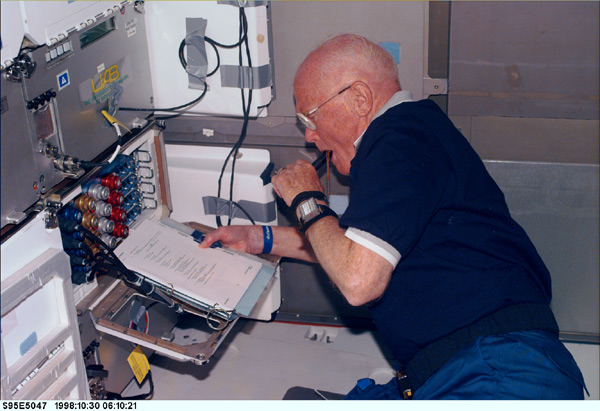Studying bone loss in space with OSTEO
The OSTEO experiments are one of Canada's great successes in space. Launched on October 29, 1998, aboard the Space Shuttle Discovery on a mission devoted to the study of aging, the experiments gave life scientists their first opportunity to examine bone cell cultures in space.

Astronaut John Glenn reviews the procedures before beginning the work. (Credit: NASA)
The three OSTEO experiments
Conducted by veteran astronaut John Glenn, the three experiments selected focussed on bone degeneration and on a possible treatment for osteoporosis.
An experiment to examine how space travel causes osteoporosis symptoms to appear was conducted by Dr. John Davies of the University of Toronto's the Centre for Biomaterials. Dr. Peter Loomer of the University of British Columbia conducted the second experiment to look into the effects of microgravity on bone formation and mechanisms that cause the disease. Dr. Dennis Sindrey, Project Director of the Allelix Biopharmaceuticals Group, analyzed the effects of hormone therapy in treating osteoporosis for the third experiment.
The Canadian Space Agency (CSA) supported Millenium Biologix for the design of the OSTEO mini-lab, which tested the growth of cells using a synthetic bone biomaterial. With the lab and the company's synthetic substitute Osteologic that mimics bone structure, they studied 192 previously cultivated bone cell samples. Today, a medical version of this biomaterial, called Skelite, is used in Canada, the United States, and Europe to heal fractures. Skelite reproduces the chemical composition and physical structure of natural bone and promotes rapid healing of weakened or injured bone. The bone-graft substitute is implanted and, over time, it is absorbed and replaced by living tissue.
Following OSTEO's success, Millenium has developed improved systems to study bone loss and tissue engineering and has attracted the attention of a number of space agencies for future experiments in this area.

The OSTEO experiments were conducted on stacked trays like this one. Colours were used to make the astronaut's task easier. (Credit: CSA)

Porous 3-D Skelite synthetic scaffolds (Credit: Millenium Biologix)
Why study osteoporosis in space?
In Canada, one in four women and one in eight men over the age of 50 suffer from osteoporosis, and its treatment costs Canadians more than $600 million annually.
Space research helps us better understand this condition and helps astronauts prepare for lengthy space missions. A microgravity environment affects an astronaut's physiology with bone deterioration 10 times more rapid than that of osteoporosis patients on Earth. The reason for this loss caused by microgravity is still being studied so treatments can be improved.

John Glenn during the OSTEO experiment (Credit: NASA)
OSTEO findings

Microscopic view of healthy (left) and osteoporotic (right) bone tissue
In the OSTEO experiments, the researchers found that isolated bone cells in space take longer to regenerate than on Earth. This slower regeneration is aggravated by the hastened action of cells that cause bone deterioration. Their significant findings show that the Earth's gravitational force may affect cells directly.
The experiment inspired the creation of a Millenium-designed clinical system called ACTES. This system enables health-care establishments, especially those outside large urban centres, to produce organic tissue without relying on an often costly and distant independent supply.
OSTEO research continues
However, the OSTEO experiment will continue with eOSTEO, set to launch in 2007. Stay tuned!